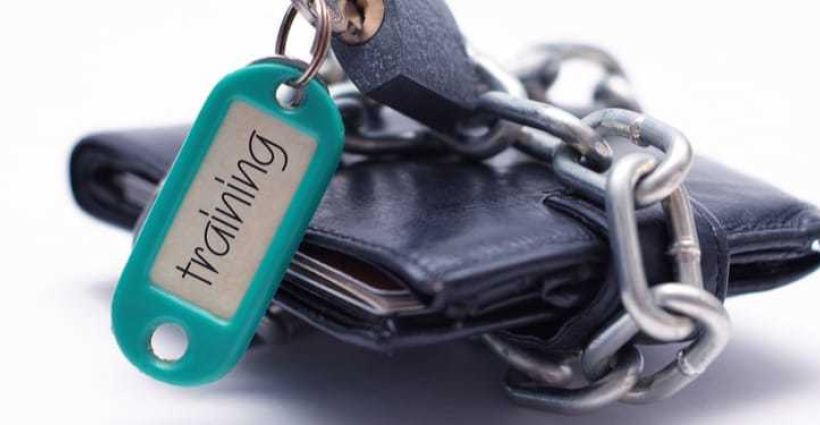Help! My Organization Wants to Nearly Eliminate Safety Training

Making the Connection
A lot of employers want to know if there is a specific, minimum amount of time that their organizations must spend on safety training. They want to do less, not more, and only what’s required by law. They fail to make the connection between having a quality safety training program, and reduction in workers compensation claims.
If you are facing this question where you work, I want you answer a question with a question:
“How much time do you feel is enough time for safety training and how do you know?”
But back to the original question, I can think of two requirements specifying time-in-training…
OSHA 10 and 30-hour courses require 10 or 30 hours of actual training in order to get the completion card. The HAZWOPER law (1910.120) is also peppered with time requirements for portions of that law.
For general safety training topics related to hazard exposure, no, OSHA does not specify time-in-training requirements. OSHA specifically details what training content needs to include, then it is up to the employer to ensure every single detail of the training requirements written into the law are covered in training. However long that takes is up to the employer, as long as every element is covered AND knowledge transfer occurred to ensure the employee can be successful in not experiencing an injury or illness.
It is fair to ask if employers would actually welcome specific time-in-training requirements for each topic. You and I know many would not. So OSHA standards for training leave employers with a level of operational autonomy that supports compliance and encourages training for safe working behaviors. The absence of clarity is a gift, in other words, not a hindrance, and not certainly not a license to subvert the intent of the law.
Requirements
Let’s look at OSHA’s training requirements for confined spaces (29 CFR 1910.146):
1910.146(g)
Training.
1910.146(g)(1)
The employer shall provide training so that all employees whose work is regulated by this section acquire the understanding, knowledge, and skills necessary for the safe performance of the duties assigned under this section.
1910.146(g)(2)
Training shall be provided to each affected employee:
1910.146(g)(2)(i)
Before the employee is first assigned duties under this section;
1910.146(g)(2)(ii)
Before there is a change in assigned duties;
1910.146(g)(2)(iii)
Whenever there is a change in permit space operations that presents a hazard about which an employee has not previously been trained;
1910.146(g)(2)(iv)
Whenever the employer has reason to believe either that there are deviations from the permit space entry procedures required by paragraph (d)(3) of this section or that there are inadequacies in the employee's knowledge or use of these procedures.
1910.146(g)(3)
The training shall establish employee proficiency in the duties required by this section and shall introduce new or revised procedures, as necessary, for compliance with this section.
1910.146(g)(4)
The employer shall certify that the training required by paragraphs (g)(1) through (g)(3) of this section has been accomplished. The certification shall contain each employee's name, the signatures or initials of the trainers, and the dates of training. The certification shall be available for inspection by employees and their authorized representatives.
1910.146(g)(1) -- The employer shall provide training so that all employees whose work is regulated by this section acquire the understanding, knowledge, and skills necessary for the safe performance of the duties assigned under this section.
1910.146(g)(2) -- Training shall be provided to each affected employee:
(i) Before the employee is first assigned duties under this section;
(ii) Before there is a change in assigned duties;
(iii) Whenever there is a change in permit space operations that presents a hazard about which an employee has not previously been trained;
(iv) Whenever the employer has reason to believe either that there are deviations from the permit space entry procedures required by paragraph (d)(3) of this section or that there are inadequacies in the employees knowledge or use of these procedures.
1910.146(g)(4) -- The employer shall certify that the training required by paragraphs (g)(1) through (g)(3) of this section has been accomplished. The certification shall contain each employee's name, the signatures or initials of the trainers, and the dates of training. The certification shall be available for inspection by employees and their authorized representatives.
And OSHA’s training requirements for hearing protection (29 CFR 1910.95):
"Training program."
1910.95(k)(1)
The employer shall train each employee who is exposed to noise at or above an 8-hour time weighted average of 85 decibels in accordance with the requirements of this section. The employer shall institute a training program and ensure employee participation in the program.
1910.95(k)(2)
The training program shall be repeated annually for each employee included in the hearing conservation program. Information provided in the training program shall be updated to be consistent with changes in protective equipment and work processes.
1910.95(k)(3)
The employer shall ensure that each employee is informed of the following:
1910.95(k)(3)(i)
The effects of noise on hearing;
1910.95(k)(3)(ii)
The purpose of hearing protectors, the advantages, disadvantages, and attenuation of various types, and instructions on selection, fitting, use, and care; and
1910.95(k)(3)(iii)
The purpose of audiometric testing, and an explanation of the test procedures.
1910.95(l)
"Access to information and training materials."
The employer shall make available to affected employees or their representatives copies of this standard and shall also post a copy in the workplace.
1910.95(l)(2)
The employer shall provide to affected employees any informational materials pertaining to the standard that are supplied to the employer by the Assistant Secretary.
1910.95(l)(3)
The employer shall provide, upon request, all materials related to the employer's training and education program pertaining to this standard to the Assistant Secretary and the Director.
"Recordkeeping" -
1910.95(m)(1)
"Exposure measurements." The employer shall maintain an accurate record of all employee exposure measurements required by paragraph (d) of this section.
"Audiometric tests."
1910.95(m)(2)(i)
The employer shall retain all employee audiometric test records obtained pursuant to paragraph (g) of this section:
1910.95(m)(2)(ii)
This record shall include:
1910.95(m)(2)(ii)(A)
Name and job classification of the employee;
1910.95(m)(2)(ii)(B)
Date of the audiogram;
1910.95(m)(2)(ii)(C)
The examiner's name;
1910.95(m)(2)(ii)(D)
Date of the last acoustic or exhaustive calibration of the audiometer; and
1910.95(m)(2)(ii)(E)
Employee's most recent noise exposure assessment.
1910.95(m)(2)(ii)(F)
The employer shall maintain accurate records of the measurements of the background sound pressure levels in audiometric test rooms.
"Record retention." The employer shall retain records required in this paragraph (m) for at least the following periods.
Noise exposure measurement records shall be retained for two years.
1910.95(m)(3)(ii)
Audiometric test records shall be retained for the duration of the affected employee's employment.
"Access to records." All records required by this section shall be provided upon request to employees, former employees, representatives designated by the individual employee, and the Assistant Secretary. The provisions of 29 CFR 1910.1020 (a)-(e) and (g)-(i) apply to access to records under this section.
"Transfer of records." If the employer ceases to do business, the employer shall transfer to the successor employer all records required to be maintained by this section, and the successor employer shall retain them for the remainder of the period prescribed in paragraph (m)(3) of this section.
Covering the Topics
If your organization believes it can adequately cover training topics and meet the standard requirements for both topics with a 3-5 minute video…THEY ARE WRONG.
In fact, our instructional design team, all professionally educated in adult learning theory, work alongside industry subject matter experts on each topic for which we provide training. And 20 minutes for general safety topics is the standard for online course completion, and one not easily achieved—a lot of high quality training is packed into each minute, using many creative devices to promote knowledge transfer.
Now, testing, proficiency. If your organization feels that a single question on a safety topic provides them enough assurance that employees have been trained sufficiently, then stick with the 1-question quiz. Now, how is an inspector going to view that situation? Or an insurance evaluator? Spoiler: they are going to see it much differently.
Now, I’ll hand you a useful tool. We built the Training for Compliance assessment to support safety professionals and organizations unsure how to build the right training program for the whole organization. Tip: take the quiz more than once, each time putting yourself in the shoes of a certain department to assess their needs, or even better, have department managers take the quiz to assess the teams they manage.
The final report includes training recommendations and each OSHA regulation linked to the training requirement, and the required training frequency if the law states a frequency. Not all OSHA laws have clear frequency; your final report explains that too. I designed this questionnaire to help employers determine which training is necessary for all teams in their workforce, how often it has to be done, AND THEN, to provide a final document citing applicable regulations to prove to management teams or safety committee members that you have done your due diligence.
The Plan
“How can we do training in less time?”
When faced with this same dilemma in my last job, I mapped out a 3-year training plan. Since the employer had never done any compliant training prior to my arrival, there was a lot of catch-up training to be done, just to reach compliance.
Year one was getting all the training done which was required by a law and also on topics where mandatory training isn’t required; yet, we were experiencing high (costly) levels of injury (example: ladder safety & back safety).
Year two was a combination of all topics with an annual training requirement and a few topics without annual training requirements (ladder safety).
Year three was a combination of all the annually required topics with a few topics that didn’t have annual requirements (back safety). I had a list of topics that didn’t have annual requirements, yet our employees had exposure to hazards and I divided them in half. In year two, they got half of those and in year three they got the other half.
After taking the quiz, you will have a list of courses to which your employees have hazard exposure, yet there isn’t a law requiring training or annual training. It is one way to show that in year one you will be doing more training just to get in compliance and in subsequent years, training hours will decrease. Additionally, we have 5-Minute refresher courses. Use those anytime the law is fuzzy and doesn’t require annual training after 1-time compliance training is complete. You can also use the 5 min courses when an employee has violated a safety rule and needs re-training or just to keep a topic top-of-mind.
Learn more about safety training online.



